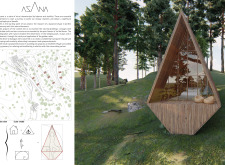5 key facts about this project
The project in Val de Moses embraces principles of balance and stability found in the practice of Asana. Located among the serene pine forests, the design seeks to create a retreat that promotes psychophysical well-being. It focuses on connecting the structure with nature, encouraging a relationship that enhances the overall experience for its users.
Design Concept
The design process began with careful observation of local building forms, especially cottages featuring pitched roofs and tent-like structures. This analysis informed the dimensions and layouts of the sleeping pods, which were developed using the golden ratios to ensure harmony with their natural setting. The result is a design that aims to fit comfortably into the landscape while offering a peaceful space for relaxation.
Spatial Organization
The layout is thoughtfully arranged, with specific areas designated for relaxation and meditation. These spaces are crafted to enhance mindfulness, featuring clear pathways and functional zones that invite users to engage with both interior and exterior settings. The design prioritizes the user experience, allowing for a strong interaction with the surrounding environment.
Material Selection
Materials play an important role in the construction, emphasizing sustainability and connection to nature. Wood is used as the main structural element and for cladding, lending warmth to the design. The façade incorporates plexiglass to let in natural light, bridging the gap between indoor spaces and the outdoors. Steel is utilized for various carpentry elements, offering structural support, while metal bars enhance stability. Foundations are constructed from durable materials, providing a solid base across different terrains.
Functional Adaptability
A key feature of the sleeping pods is their adaptability, allowing them to be placed on various terrains with foundations designed on poles. This approach offers versatility and the option for relocation if needed. Each pod is crafted to accommodate different landscapes without sacrificing stability or visual appeal.
The sloping walls of the sleeping pods contribute to an engaging visual presence and enhance the overall experience while maintaining a connection with the surrounding nature. These thoughtful design choices reflect a commitment to blending architecture harmoniously with the environment.






















































